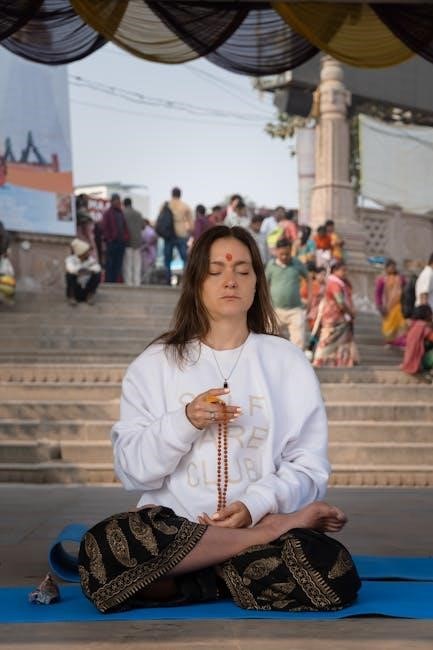Yoga Vasistha, also known as Maha Ramayana, is an ancient Indian text comprising 32,000 verses. It explores Rama’s spiritual journey, offering deep philosophical insights into non-dualism and self-realization.
Background and Significance
Yoga Vasistha, known as Maha Ramayana, is a revered Indian text blending philosophy and storytelling. Comprising 32,000 verses, it explores Rama’s spiritual evolution. This scripture, deeply rooted in Advaita Vedanta, emphasizes non-dualism and self-realization. It has profoundly influenced Indian philosophy, offering practical mysticism and teachings on consciousness. Its unique blend of narrative and spiritual wisdom has made it a cornerstone for seekers. Available in PDF formats, including condensed versions like Laghu Yoga Vasistha, it remains accessible for modern readers, with translations by scholars like Swami Venkatesananda preserving its timeless essence.
Overview of the Text
Yoga Vasistha, also known as Maha Ramayana and Uttar Ramayana, is a comprehensive text detailing Prince Rama’s spiritual evolution. Composed of 32,000 verses and 64,000 lines, it explores themes of non-dualism, consciousness, and liberation. The text blends philosophical discourse with narrative, offering practical mystical insights. Its elaborate structure divides into sections, each addressing profound existential questions. Available in PDF formats, including condensed versions like Laghu Yoga Vasistha, it remains a vital resource for spiritual seekers, combining storytelling with profound teachings on Advaita Vedanta and self-realization, making it accessible to modern readers seeking timeless wisdom.

Historical Context
Yoga Vasistha, an influential text before the 12th century, shaped Indian Yoga culture and inspired medieval Advaita Vedanta scholars, blending philosophy with practical spiritual guidance.
Date and Authorship
Yoga Vasistha is attributed to the legendary sage Valmiki, though its exact date remains uncertain. Scholars suggest it was composed between the 11th and 14th centuries CE. This text, also known as the Maha Ramayana, blends philosophical discourse with narrative, making it a unique Puranic work. While traditionally credited to Valmiki, authorship likely involved multiple contributors over time. Its influence peaked before the 12th century, shaping Yoga culture and Advaita Vedanta thought. Despite its unclear origins, Yoga Vasistha remains a cornerstone of Indian philosophy, offering timeless wisdom on spirituality and self-realization.
Cultural and Philosophical Influence
Yoga Vasistha profoundly shaped Indian philosophy, particularly Advaita Vedanta, emphasizing non-dualism and self-realization. Its practical mysticism influenced Yoga culture and spirituality, offering insights into meditation and breath control. This text is revered for its philosophical depth, blending Puranic narratives with spiritual teachings. It has inspired scholars and practitioners across centuries, remaining a cornerstone of Indian thought. Its influence extends to modern spirituality, with translations and commentaries making its wisdom accessible globally. Yoga Vasistha’s teachings on consciousness and liberation continue to guide seekers, enriching cultural and philosophical landscapes with its timeless insights into the nature of reality and existence.

Structure and Content
The Yoga Vasistha is divided into two main sections, with the first containing 1,500 verses and the second comprising 30,500 verses, totaling 32,000 verses and 64,000 lines.
32,000 Verses and 64,000 Lines
Yoga Vasistha is an extensive text, comprising 32,000 verses and 64,000 lines, making it one of the most elaborate works in Indian philosophical literature. Its vast structure reflects the depth of its teachings, covering a wide range of spiritual and philosophical topics. The text is divided into two main sections, with the first containing 1,500 verses and the second comprising 30,500 verses. This intricate composition underscores its significance as a comprehensive guide to spiritual growth and self-realization. The sheer volume of the text emphasizes its richness and the detailed exploration of non-dualism and liberation.
Divisions and Chapters
Yoga Vasistha is divided into two main parts: the first containing approximately 1,500 verses and the second comprising 30,500 verses. These sections are further subdivided into chapters, each focusing on specific themes and teachings. The text is structured to guide readers through Rama’s spiritual journey, from initial inquiries to profound realizations. Each chapter explores complex philosophical concepts, making the text accessible for progressive study. This organized structure allows readers to delve into its teachings systematically, ensuring a comprehensive understanding of its non-dualistic philosophy and practical mysticism.

Key Concepts and Teachings
Yoga Vasistha emphasizes Advaita Vedanta, exploring non-dualism, consciousness, and self-realization. It teaches practical mysticism, highlighting the role of the guru and the path to liberation through self-inquiry and introspection.
Advaita Vedanta and Non-Dualism
Yoga Vasistha deeply explores Advaita Vedanta, emphasizing non-dualism as its core philosophy. It teaches that the ultimate reality, Brahman, is the only truth, and the universe is an illusion (Maya). Through stories and dialogues, it guides seekers to realize the unity of the individual self (Atman) with Brahman, leading to liberation. This text underscores the practical application of non-dual principles in daily life, offering a path to transcendental wisdom and self-realization. Its teachings remain central to Vedantic thought, influencing both medieval and modern interpretations of Indian philosophy.
Practical Mysticism
Yoga Vasistha is renowned for its emphasis on practical mysticism, blending philosophical truths with actionable spiritual practices; It provides detailed guidance on meditation, self-inquiry, and breath control (pranayama) to attain self-realization. The text encourages seekers to move beyond theoretical knowledge, embracing direct experience of the divine. Its teachings are accessible, offering tools for everyday life to cultivate inner peace and wisdom. This approach makes it a cherished resource for those seeking both spiritual growth and practical application, ensuring its relevance for modern seekers of truth and enlightenment.
The Role of the Guru
The Yoga Vasistha underscores the role of the guru as a spiritual guide and mentor. Vasistha, Rama’s guru, imparts profound wisdom, helping him navigate the path to self-realization. The guru’s teachings emphasize practical applications of spiritual truths, moving beyond theoretical knowledge. The text highlights the guru’s ability to dispel illusions and guide the seeker toward liberation. This relationship exemplifies the traditional Indian guru-disciple dynamic, where the guru’s guidance is essential for spiritual growth. Yoga Vasistha thus remains a timeless resource for understanding the guru’s pivotal role in attaining enlightenment and applying these teachings in daily life for modern seekers.

Central Themes
Yoga Vasistha explores Rama’s evolving wisdom, the nature of reality, and liberation through self-realization, offering profound insights into consciousness and existence, guiding seekers on their spiritual journey.
The Evolution of Rama’s Wisdom
The Yoga Vasistha chronicles the transformation of Rama from a prince grappling with existential questions to a wise sage embodying self-realization. Through dialogues with sages like Vasistha, Rama’s understanding deepens, moving from doubt to clarity. The text vividly portrays his journey, highlighting the progression of his thoughts and emotions. This evolution is central to the narrative, illustrating the path from ignorance to enlightenment. Rama’s wisdom grows through introspection and teachings, making him a symbol of spiritual awakening. His story serves as a timeless guide for seekers of truth and liberation.
The Nature of Reality and Consciousness
Yoga Vasistha explores the nature of reality as an illusion (Maya) and consciousness as the ultimate truth. It teaches that the universe is a projection of the mind, emphasizing non-dualism. The text clarifies that reality is not separate from consciousness but is its manifestation. Through practical mysticism, it guides seekers to understand the illusory nature of the world and attain self-realization. This philosophical framework encourages introspection and self-inquiry to transcend the limitations of the material world and experience the true essence of existence.
Liberation and Self-Realization
Liberation (Moksha) is a central theme in Yoga Vasistha, achieved through mental discipline and renunciation of worldly attachments. It emphasizes self-inquiry and the realization of one’s true nature. The text underscores the mind’s role in both bondage and liberation, advocating for detachment and understanding the illusory nature of the world. Through meditation and dispassion, one attains freedom from suffering. Yoga Vasistha guides seekers to transcend the cycle of birth and death, ultimately merging with the absolute consciousness. This path to self-realization is practical and profound, offering timeless wisdom for spiritual aspirants.

Philosophical Framework
Yoga Vasistha integrates Vedanta and Yoga, emphasizing non-dualism and the nature of consciousness. It explores the ultimate reality, blending philosophical inquiry with practical spiritual practices for self-realization.
Vedanta and Yoga
Yoga Vasistha seamlessly integrates Vedanta and Yoga, offering a holistic path to liberation. Vedanta provides the metaphysical foundation, while Yoga offers practical methods for self-realization. The text emphasizes the unity of consciousness, blending philosophical inquiry with yogic practices like meditation and pranayama. This synthesis allows seekers to transcend the limitations of the mind and realize their true nature. By combining the theoretical framework of Vedanta with the practical techniques of Yoga, Yoga Vasistha creates a comprehensive guide for spiritual growth and self-discovery, making it a revered text in both traditions.
The Path of Self-Inquiry
Yoga Vasistha emphasizes the path of self-inquiry as a direct means to liberation. It guides seekers to introspect and question the nature of the self, distinguishing it from the non-self. This method, rooted in Advaita Vedanta, encourages individuals to look beyond illusions and realize their true essence. The text underscores the role of the Guru in illuminating this path, offering practical wisdom for spiritual seekers. Through self-inquiry, one transcends the mind’s limitations, leading to profound understanding and liberation. This approach remains timeless, making Yoga Vasistha a cherished resource for those seeking self-realization.
- Self-inquiry is central to spiritual growth.
- The Guru plays a pivotal role in guiding this journey.
- Understanding the self and non-self is crucial.
Practical Applications
Yoga Vasistha offers practical techniques for spiritual growth, including meditation, pranayama, and Om chanting, which aid in breath control, mental clarity, and self-realization.
- Meditation
- Pranayama
- Om chanting
Meditation and Pranayama
Meditation and pranayama are central practices in Yoga Vasistha, offering pathways to mental clarity and self-realization. Pranayama, the science of breath control, regulates life force (prana), balancing the body and mind. Meditation, particularly on the sacred sound Om, helps transcend worldly distractions, fostering inner peace. These techniques, rooted in ancient wisdom, guide seekers to still the mind and attain spiritual awareness. The text emphasizes their systematic practice as essential for overcoming mental agitation and achieving liberation. Through these disciplines, one aligns with the ultimate reality, embodying the teachings of Yoga Vasistha.
- Pranayama: Breath control for balance
- Meditation: Focus on Om for transcendence
- Inner peace and self-realization
The Science of Breath Control
The Yoga Vasistha elaborates on pranayama, the science of breath control, as a vital practice for regulating the life force (prana). By mastering breath, one balances the nervous system, calms the mind, and prepares for meditation. The text describes techniques to harmonize inhalation, retention, and exhalation, emphasizing their role in spiritual growth. Breath control is seen as a bridge between physical and mental disciplines, enabling the practitioner to transcend external distractions and focus inward. This practice is essential for achieving mental clarity and advancing toward self-realization, as outlined in the teachings of Yoga Vasistha.
- Pranayama regulates life force
- Breath techniques for mental balance
- Preparation for deeper meditation
Om and Pranava Yoga
Pranava Yoga, as described in the Yoga Vasistha, revolves around the sacred sound Om, considered the controller of the life force (prana). Om is the most revered syllable in yoga, symbolizing the Absolute and the essence of consciousness. The text emphasizes meditation on Om to transcend the material world and attain spiritual unity. By chanting Om, practitioners connect with the divine, fostering introspection and self-realization. This practice is central to achieving liberation, as it aligns the individual self with the universal consciousness, embodying the non-dualistic philosophy of Advaita Vedanta.
- Om as the sacred sound of prana
- Meditation on Om for spiritual unity
- Connection to Advaita Vedanta philosophy
Modern Relevance
Yoga Vasistha’s timeless wisdom resonates today, offering insights into stress management, mental well-being, and holistic living. Its lessons on consciousness and self-realization remain universally applicable.
Contemporary Interpretations
Modern scholars and spiritual seekers reinterpret Yoga Vasistha’s teachings, emphasizing their relevance to contemporary life. Its philosophical themes of non-dualism and self-realization resonate deeply in today’s world. The text’s practical mysticism offers guidance for mental well-being, stress management, and holistic living. Swami Venkatesananda’s English translation has made the scripture accessible to global audiences. Digital formats, including PDF versions, further enhance its reach, allowing modern readers to explore its wisdom. The text’s emphasis on consciousness and inner peace aligns with current interests in mindfulness and meditation, making it a valuable resource for personal growth and spiritual exploration in the 21st century.
Applications in Daily Life
Yoga Vasistha’s teachings offer practical wisdom for daily living, emphasizing self-awareness and mindfulness. Its principles guide individuals in managing stress, cultivating mental clarity, and fostering inner peace. Techniques like meditation and pranayama, detailed in the text, can be integrated into routines to enhance well-being. The philosophy encourages introspection and emotional balance, aiding in personal growth. With PDF versions widely available, readers can easily access these teachings, applying them to navigate life’s challenges with greater resilience and harmony. This ancient wisdom remains a valuable resource for modern lifestyles, promoting holistic health and spiritual fulfillment. Its relevance endures, enriching daily lives profoundly.

Availability in PDF Format
Yoga Vasistha is widely available in PDF format, enabling easy access for readers worldwide. Downloadable versions allow spiritual seekers to study and reflect on its teachings conveniently.
Downloading and Reading Online
Yoga Vasistha is readily available for download in PDF format, making it accessible to spiritual seekers worldwide. Various online platforms offer free downloads, allowing readers to explore its profound teachings. The text can be easily searched and read on digital devices, facilitating deeper study and reflection. Many websites provide direct links to download the full or condensed versions, ensuring convenience for those interested in its philosophical insights. Additionally, online libraries and spiritual forums often host downloadable versions, catering to both beginners and advanced practitioners seeking to delve into its wisdom. This accessibility has made Yoga Vasistha a widely studied scripture globally.
Condensed Versions (Laghu Yoga Vasistha)
The Laghu Yoga Vasistha is a concise version of the original text, simplifying its vast philosophical content for easier understanding. This abridged form retains the core teachings while reducing the verse count, making it accessible to those seeking essential insights without delving into the full text. Scholars and translators have created this condensed version to cater to modern readers, ensuring the profound wisdom of Yoga Vasistha remains relevant and digestible. It serves as an ideal introduction for newcomers and a convenient reference for advanced practitioners, preserving the text’s spiritual depth in a more manageable format.

Translations and Commentaries
Swami Venkatesananda’s English translation of Yoga Vasistha is highly regarded, offering insightful commentary. Other notable translations have made this text accessible to diverse audiences worldwide.
English Translations by Swami Venkatesananda
Swami Venkatesananda’s English translation of Yoga Vasistha is a seminal work, providing profound insights into its philosophical and spiritual teachings. His rendition, accompanied by concise expositions, makes the text accessible to modern readers. As part of the Divine Life Society in Rishikesh, Swami Venkatesananda’s translation is widely regarded for its clarity and depth. The PDF version of his work is popular among spiritual seekers, offering a bridge between ancient wisdom and contemporary understanding. His commentary ensures that the complex concepts of Yoga Vasistha are made understandable, preserving its essence while catering to global audiences.
Other Notable Translations
Beyond Swami Venkatesananda’s version, Yoga Vasistha has seen other notable translations. Swami Jyotirmayananda’s rendition is praised for its fidelity to the original text while making it accessible. Additionally, modern scholars have contributed translations, blending traditional insights with contemporary language. These efforts ensure Yoga Vasistha’s timeless wisdom reaches diverse audiences. PDF versions of these translations are widely available, facilitating global access to this revered text. Such translations not only preserve the essence but also enhance its relevance for today’s spiritual seekers, ensuring its teachings endure across generations and cultures.

Study and Practice
Yoga Vasistha offers profound teachings for both beginners and advanced seekers. Guides and resources provide structured approaches to its philosophy, while practical techniques like meditation and self-inquiry aid spiritual growth.
Guides for Beginners
For newcomers, the Laghu Yoga Vasistha offers a condensed version of the original text, making it easier to grasp. Swami Venkatesananda’s English translation provides clear explanations, ideal for those new to Advaita Vedanta. Beginners can start with foundational concepts like practical mysticism and self-inquiry. Meditation and breath control techniques, such as pranayama, are introduced as tools for spiritual growth. The text encourages starting with short, focused studies and applying its teachings to daily life. Consistency and patience are emphasized, allowing learners to gradually absorb the profound wisdom of Yoga Vasistha.
Advanced Study Resources
For advanced learners, the complete Yoga Vasistha in PDF offers profound insights into non-dualism and liberation. Swami Venkatesananda’s translation is highly recommended for its depth and clarity; Scholars and practitioners can explore detailed commentaries and analyses that delve into the text’s philosophical framework. Advanced study resources include in-depth examinations of its teachings on consciousness and reality. These materials are ideal for those seeking a deeper understanding of Advaita Vedanta and its practical applications. The full text, available online, provides a comprehensive guide for serious students of Indian philosophy and spirituality.

Impact and Legacy
Yoga Vasistha has profoundly influenced Indian philosophy, serving as a foundational text for medieval Advaita Vedanta scholars. Its teachings continue to inspire modern spiritual and philosophical inquiries, ensuring its enduring legacy.
Influence on Indian Philosophy
Yoga Vasistha has been a foundational text for medieval Advaita Vedanta scholars, shaping their understanding of non-dualism and self-realization. Its integration of Vedanta and Yoga philosophies created a unique framework that influenced Indian spiritual thought. The text’s emphasis on practical mysticism and self-inquiry resonated deeply, inspiring generations of philosophers and practitioners; Its teachings on consciousness and reality remain central to Indian philosophical discourse, ensuring its enduring relevance in both spiritual and academic circles.
Modern Scholarship and Research
Modern scholarship has actively engaged with Yoga Vasistha, recognizing its profound philosophical depth. Ongoing translations, such as the new rendition of Books 1-2, and the efforts of scholars like Swami Venkatesananda, have made the text more accessible. A dedicated Google Group fosters discussion and sharing of insights, while condensed versions like Laghu Yoga Vasistha cater to contemporary readers. Researchers like Dr. Atreyas contribute by elucidating key concepts, making the text’s teachings relevant today. This collaboration between scholars and practitioners ensures Yoga Vasistha remains a vital resource for spiritual and academic exploration, bridging ancient wisdom with modern understanding.



